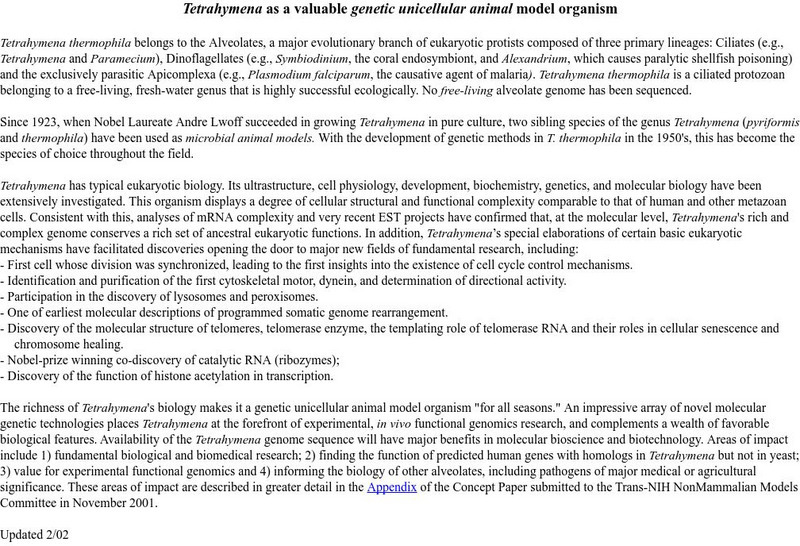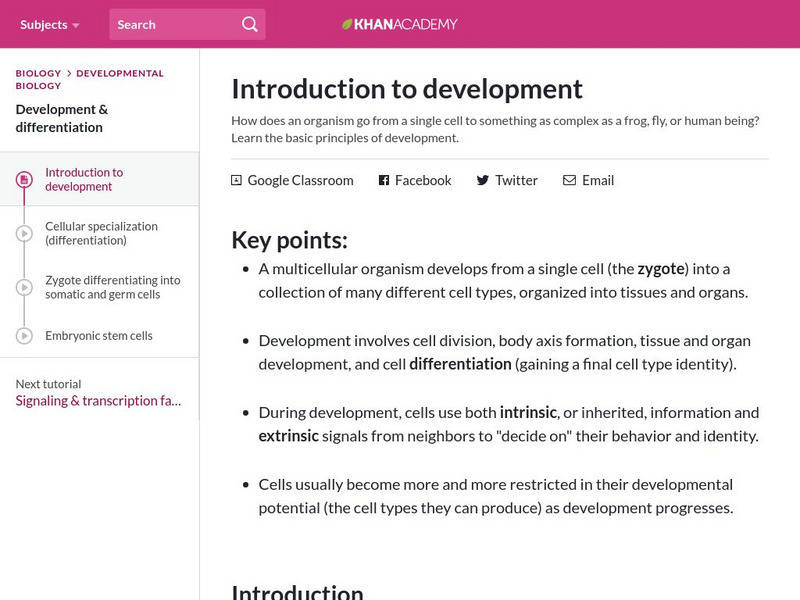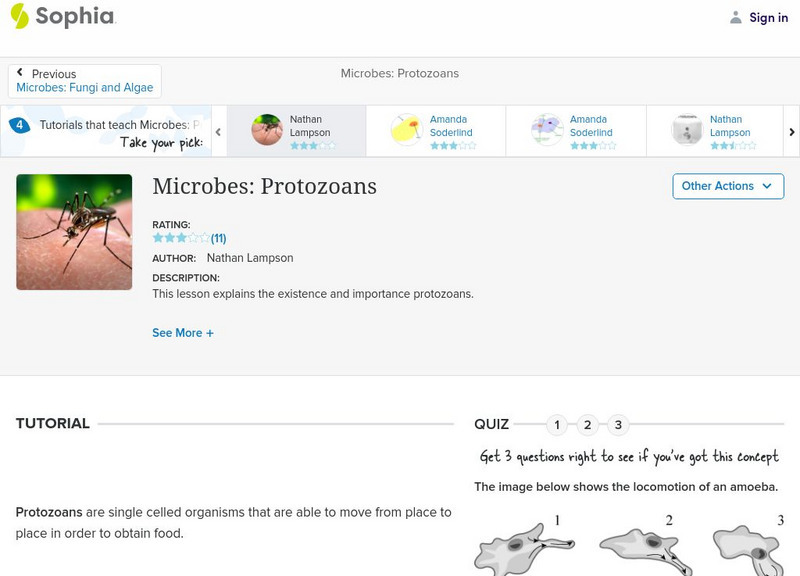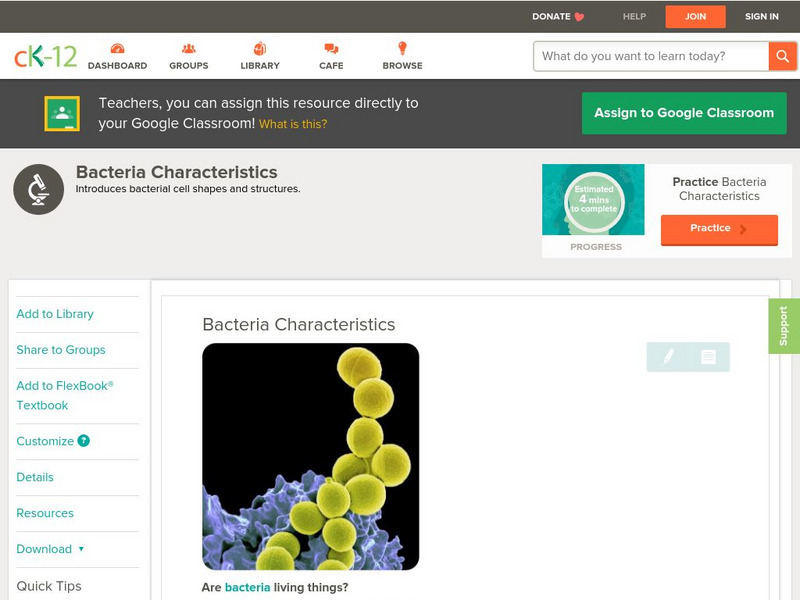Curated OER
Algae
In this biology activity, students identify and locate various vocabulary terms pertaining to algae. There are 54 biology terms located in the word search.
University of South Florida
Project Oceanography: Single Celled Organisms [Pdf]
For this lesson, students explore three kinds of symbiotic relationships involving unicellular organisms. They will also look more closely at the relationship between zooxanthellae and coral, and the importance of nitrogen-fixing...
TED Talks
Ted: Ted Ed: What Is the Biggest Single Celled Organism?
The elephant is a creature of epic proportions- and yet, it owes its enormity to more than 1,000 trillion microscopic cells. And on the epically small end of things, there are likely millions of unicellular species, yet there are very...
TED Talks
Ted: Ted Ed: How a Single Celled Organism Almost Wiped Out Life on Earth
Anusuya Willis explains how cyanobacteria, simple organisms that don't even have nuclei or any other organelles, wrote a pivotal chapter in the story of life on Earth. [4:14]
Howard Hughes Medical Institute
Hhmi: Biointeractive: The Eukaryotic Cell Cycle and Cancer
Cell division is the only way single-celled organisms can reproduce. Learn more about cell division and explore the phases, checkpoints, and protein regulators of the cell cycle in this interactive. Find out how mutated versions of these...
TeachEngineering
Teach Engineering: Cell Celebration!
Students look at the components of cells and their functions. The lesson focuses on the difference between prokaryotic and eukaryotic cells. Each part of the cell performs a specific function that is vital for the cell's survival....
CK-12 Foundation
Ck 12: Biology: Organization of Cells
[Free Registration/Login may be required to access all resource tools.] Learn how multicelled organisms have specialized cells that do specific jobs and single celled organisms exist without the help of other cells.
National Geographic
National Geographic: Blog: Tiny Critter Has Seven Sexes
Meet the freshwater Tetrahymena, a single-celled creature that has seven possible sexes. This article presents information from recent research that helps explain how the creature reproduces and how its sex is determined.
Bio Topics
Bio Topics: Bacterial Cell Structure
An information page about the structure of the single-celled organism, bacteria. Learn about their major parts and size.
Science Education Resource Center at Carleton College
Serc: Observe, Describe, Compare and Contrast Cells
This investigation allows students to observe cells from multiple sources. Plant, animal and bacterial cells will be observed as well as cells from multicellular organisms and single-celled organisms. After providing written descriptions...
PBS
Pbs Learning Media: Cell Differentiation
In this video segment from The Secret of Life school video, "Sex and the Single Gene" follow as a single fertilized egg cell divides, differentiates, and assembles into the tissues and organs of a new organism. [1:20]
Khan Academy
Khan Academy: Cell Cell Signaling in Unicellular Organisms
Article takes a look at how unicellular organisms "chat" with one another using chemical signals. It examines yeast mating types, bacterial quorum sensing, and biofilms.
Georgia Department of Education
Ga Virtual Learning: Biology: Taxonomy
In this multi-media module students derive the relationship between single-celled and multi-celled organisms and the increasing complexity of systems.
University of California
Tetrahymena as a Unicellular Model Organism
Information on Tetrahymena thermophila and why it is an important unicellular organism.
CK-12 Foundation
Ck 12: Life Science: Bacteria Reproduction
[Free Registration/Login may be required to access all resource tools.] Bacteria, being single-celled prokaryotic organisms, do not have a male or female version. Bacteria reproduce asexually. In asexual reproduction, the "parent"...
BiologyWise
Biology Wise: Unicellular Organisms
A unicellular organism is made of only a single cell. Its characteristics are described and several examples are provided.
Khan Academy
Khan Academy: Introduction to Development
How does an organism go from a single cell to something as complex as a frog, fly, or human being? Learn the basic principles of development.
Microscopy UK
Microscopy Uk: Micscape Article Paramecium
Excellent article on a unicellular organism, the paramecium. Includes details on its environment, paramecium types, and environmental importance.
Biology Pages
Kimball's Biology Pages: The Protists
A brief, but informative paragraph describing the parasitic nature of sporozoans, part of a larger page about single-celled organisms.
CK-12 Foundation
Ck 12: Life Science: Timeline of Evolution
[Free Registration/Login may be required to access all resource tools.] For life to evolve from simple single-celled organisms to many millions of species of prokaryotic species to simple eukaryotic species to all the protists, fungi,...
CK-12 Foundation
Ck 12: Life Science: Animal Like Protists
[Free Registration/Login may be required to access all resource tools.] Animal-like protists are called protozoa. Protozoa are single-celled eukaryotes that share some traits with animals. Like animals, they can move, and they are...
Other
Society for General Microbiology: Bacteria
Bacteria are single celled microbes. The cell structure is simpler than that of other organisms as there is no nucleus or membrane bound organelles. Instead their control centre containing the genetic information is contained in a single...
Sophia Learning
Sophia: Microbes: Protozoans
This lesson describes single-celled protozoans, highlighting their modes of movement. [46 secs]
CK-12 Foundation
Ck 12: Life Science: Bacteria Characteristics
[Free Registration/Login may be required to access all resource tools.] Bacteria are the most successful organisms on the planet. They lived on this planet for two billion years before the first eukaryotes and, during that time, evolved...



![Project Oceanography: Single Celled Organisms [Pdf] Lesson Plan Project Oceanography: Single Celled Organisms [Pdf] Lesson Plan](https://d15y2dacu3jp90.cloudfront.net/images/attachment_defaults/resource/large/FPO-knovation.png)



















